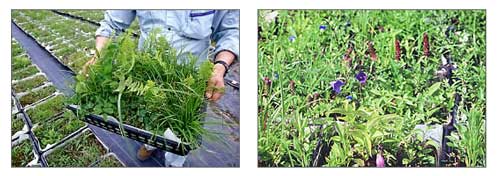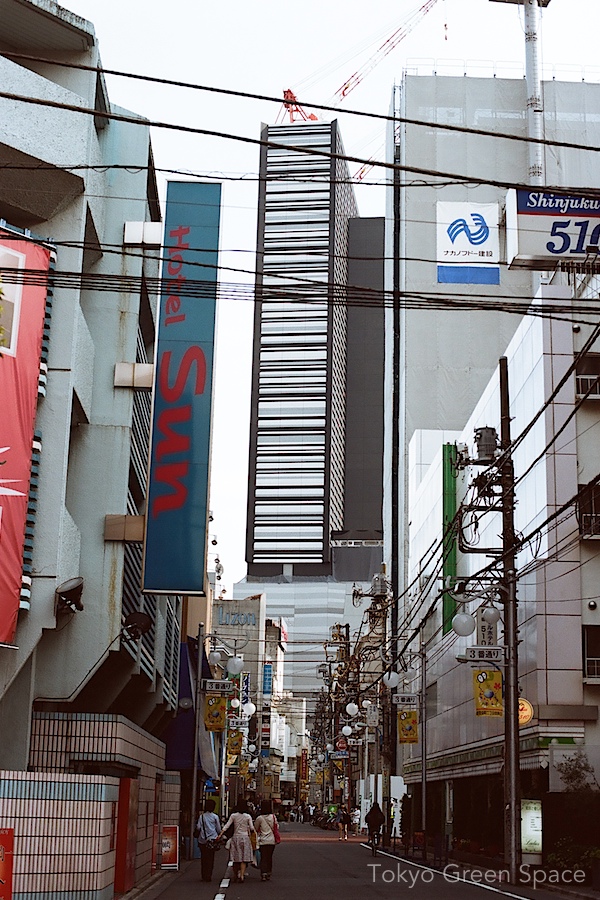
An enormous black slab of a tower is nearly complete in the center of Kabukicho. Who is going to work there? Can you imagine inviting clients to visit your office *there*?

I love this path that starts at Shinjuku Dori, near the department stores, cuts between Kabukicho and Golden Gai, and ends up at the start of the male host zone in eastern Shinjuku. I wish all my city walking could be done on this narrow green path with mature trees.


I am not sure why I find this building so fascinating. It’s built on a triangular lot, and has no visible greenery. The middle of the facade is a staircase and hallways, covered in a wall used partly for signage. The five floors of open air, window cut-outs create an ornamental pattern.

Just looking at this parking tower covered in thick ivy makes me feel a little cooler. I wonder what creatures might be living inside.
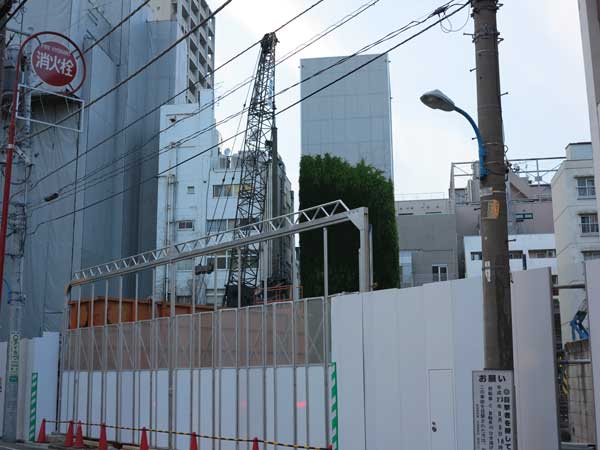

歌舞伎町に、面白い園芸に関する落書きを見つけました。女の子はじょうろからぽつぽつと水を注いでいます。黄色の手袋もブーツを持っていて、いかりの入れ墨を腕にして、電気ボルトのワンピースを着ています。
I love this horticultural graffiti on the Korea Town side of Kabukicho. A girl pours a few drops from a watering can. She’s wearing matching gloves and shoes, with an anchor tattoo on her arm and electricity bolts on her dress. I wonder what she’s growing.


酉の市が大好きです。日本の神道では、神秘的なものと幸運を探しながら、熊手やお酒や入れ墨のキューピーからご利益を得られます。浅草はもっと伝統的ですが、花園神社は私の一番のパワースポットです。歌舞伎町と二丁目とデパート本店の間だから、とてもかっこい人が集まります。三十万円の熊手を見ました。去年私は千円のを買って、今年は二千円のにレベルアップしました。来年はすばらしい年になります。
I’ve written before how Tori no Ichi is one of my favorite festivals, with its focus on seeking spiritual intervention for a prosperous year. Perhaps Asakusa is a more traditional place, but I particularly love attending the festival at Hanozono shrine, mid-way between Kabukicho, Ni-chome, and the department stores. The crowd is Tokyo’s most beautiful people: the world of late night drinkers, huge hair for men and women, animal prints, and shiny fabrics.
If it weren’t for the food stalls, it would be easy to miss the entrance on Yasukuni Dori, with the fiver rows of lanterns barely competing with the neon, fluorescent signage, and hundreds of taxis.

The focal point of the festival are the “kumade,” which are good luck rakes made of bamboo, rice, (often artificial) pine, and paper and plastic good luck charms hot glued. There are dozens of stalls, and the most expensive ones need to be carried out by two men. The one below cost 300,000 yen (almost US $4,000).

In addition to kumade sellers, there are many regular festival food stalls, and also make-shift drinking establishments with tables and chairs. I like how the one below wraps around a mature tree.

The convergence of spirituality, drinking and materialism is dizzying. The proprietress of this food and drink stall is wearing a headband full of cash.

Almost anything can represent good fortune. I love how this Kewpie doll, the mascot of Japan’s #1 mayonnaise, also has a headband of cash and a full body tattoo. There seems to be an even higher than usual correlation between this festival and the yakuza who are its sellers and celebrants.

Even the children’s cartoon Anpan man (his head is a round anko bread that can be eaten when necessary) can be incorporated into the rake.

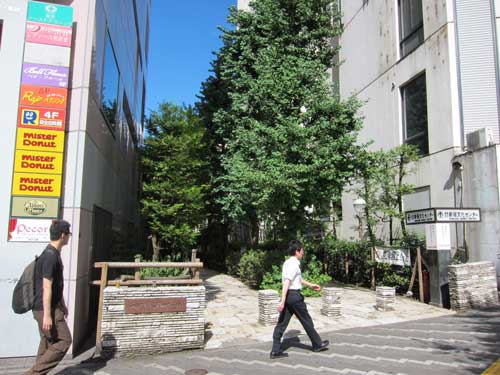
There are many small creeks in Tokyo that have been turned into pedestrian paths. In my neighborhood, they are modestly landscaped. In Shinjuku, there’s Shinjuku Yuhodo Koen Shiki no Machi (新宿遊歩道公園四季の道), an amazing green corridor with mature trees between the department stores of San Chome, Hanazono Shrine, the packed bars of Golden Gai, and Kabukicho.
Oddly, my very detailed Tokyo City Atlas does not include the path’s name. It’s easy to miss it, but once inside it feels like a magical passageway, full of life during the day and at night. Green corridors take up minimal space, and are perhaps more useful than small parks since provide a path between places.

Starting in May, summer omatsuri festivals are a public celebration of the local gods that exist in even the densest, most commercial parts of Tokyo. One of my favorite festivals is at Hanazono Shrine, in between Shinjuku san-chome, Kabukicho, and Shinjuku ni-chome, an area of department stores, fast fashion, a station with more than 2 million daily commuters, nightclubs, host clubs, and gay bars.
Above you can see a temporary shrine being constructed with metal poles, bamboo, and paper symbols outside Isetan’s flagship department store.

The festival brings together long-time residents, small business owners, and even the large commercial enterprises. The above photo shows a small neighborhood shrine, where I had previously noticed seniors playing a ring toss game. When I visited during preparations, the old timers invited me to participate in carrying their portable shrine (see below) around the neighborhood and to the main shrine. Knowing how heavy the shrine is, I politely declined.

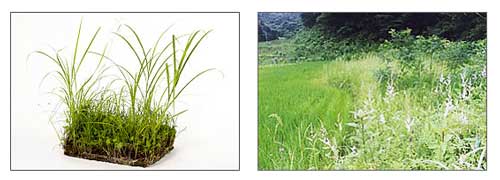 In an earlier post, I talked a little about 5bai Midori‘s street beautification products and the creative force behind this small green business Tase Michio. This post uses photos from their website to explore their idea of restoring the countryside, or satoyama(里山), and bringing it into the city.
In an earlier post, I talked a little about 5bai Midori‘s street beautification products and the creative force behind this small green business Tase Michio. This post uses photos from their website to explore their idea of restoring the countryside, or satoyama(里山), and bringing it into the city.
The photos above illustrate the concept of carving a piece of rural nature into a modular square. 5bai Midori plants these bio-diversity trays on modular metal cubes with up to five sides for plants and special light-weight soil. Applications include residential entrances, sidewalks and balconies, apartment and office buildings, green walls, rooftops, neighborhood planters, boulevard and highway guard rails, interiors, benches, and special events. They have targeted individuals, governments (including amazing, yet unrealized plans for greening Kabukicho and Marunouchi), developers and construction companies.
These are some images of how plant trays are cultivated to include a multitude of species in a small area.
